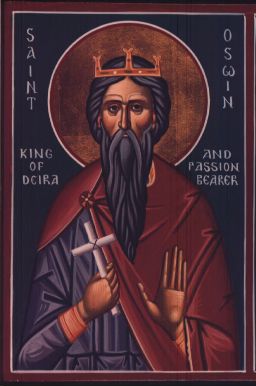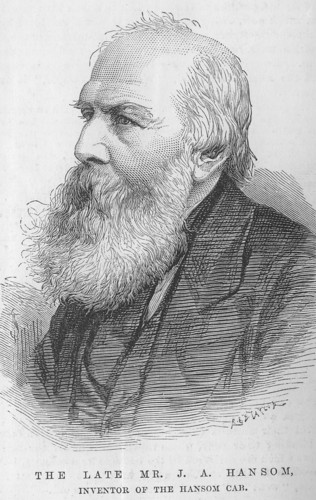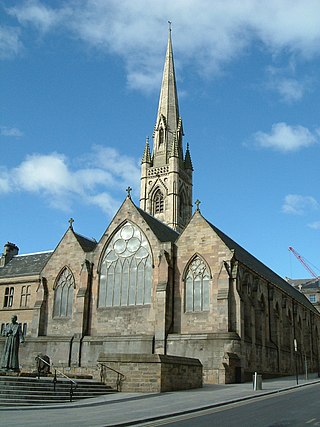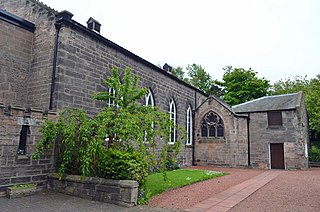
Oswine, Oswin or Osuine was a King of Deira in northern England.

Tynemouth is a coastal town in the metropolitan borough of North Tyneside, in Tyne and Wear, England. It is located on the north side of the mouth of the River Tyne, hence its name. It is 8 mi (13 km) east-northeast of Newcastle upon Tyne. The medieval Tynemouth Priory and Castle stand on a headland overlooking both the mouth of the river and the North Sea, with the town centre lying immediately west of the headland.

Joseph Aloysius Hansom was a British architect working principally in the Gothic Revival style. He invented the Hansom cab and founded the eminent architectural journal The Builder in 1843.

Tynemouth Priory and Castle is a historic site located on a promontory at the mouth of the Tyne at Tynemouth. The medieval Benedictine priory was protected by walls, towers, and a gatehouse. The heraldry of the metropolitan borough of North Tyneside includes three crowns commemorating the three kings who have been buried in the priory.

The Cathedral Church of St Mary is a Catholic cathedral in Newcastle upon Tyne, Tyne and Wear, England. It is the mother church of the Diocese of Hexham and Newcastle and seat of the Bishop of Hexham and Newcastle. The cathedral, situated on Clayton Street, was designed by Augustus Welby Pugin and built between 1842 and 1844. The cathedral is a grade I listed building and a fine example of the Gothic Revival style of architecture championed by Pugin.

Wylam is a village and civil parish in the county of Northumberland, England. It is located about 10 miles (16 km) west of Newcastle upon Tyne.
Edward Joseph Hansom was an English Victorian architect who specialised in ecclesiastical buildings in Gothic Revival style, including many Roman Catholic churches.

Archibald Matthias Dunn FRIBA, JP, was a British architect. He was, along with his partner Edward Joseph Hansom, among the foremost Catholic architects in North East England during the Victorian era.
Séamus Cunningham is an Irish-born prelate of the Roman Catholic Church in England. He was the Bishop of Hexham and Newcastle in the north of England from 2009 to 2019. He retired to the city of Sunderland and helps out as an assistant priest across the Catholic parishes in the city.

Our Lady and St Joseph's Church, is a Roman Catholic church in Carlisle, Cumbria. The church is one of seven churches that make up the city and district parish of Our Lady of Perpetual Help, Carlisle. It was built from 1891 to 1893. It is situated on the junction of Warwick Road and Warwick Square in the centre of the city. The church is a Grade II listed building.

Our Lady of Sorrows Church is a Roman Catholic Parish church in Bognor Regis, West Sussex, England. It was built from 1881 to 1882 and designed by Joseph Stanislaus Hansom. It is situated on the corner of the High Street and Clarence Road, backing on to Albert Road, in the centre of the town. It was founded by the Servite Order and is a Grade II listed building.

St Benet's Church is a Catholic church in Monkwearmouth in Sunderland. It was built in 1889 and designed by Archibald Matthias Dunn and Edward Joseph Hansom. It is located on the corner of Thomas Street North and George Street North, half a kilometre east of the Stadium of Light. From 1900 to 2011, the Redemptorists served the parish. The church is now once again served by priests from the Diocese of Hexham and Newcastle. When it was built, it was the first Catholic church in Sunderland to be built north of the River Wear in the nineteenth century.

St Dominic's Church, formerly St Dominic's Priory Church, is a Roman Catholic Parish church in Newcastle-upon-Tyne. It was built from 1869 and opened in 1873. It was founded by the Dominican Order. It is located on New Bridge Street, east of Manors railway station, in the Ouseburn area of Newcastle. It was designed by Archibald Matthias Dunn and is a Grade II listed building.

St Joseph's Church is a Roman Catholic Parish church in Hartlepool, County Durham, England. It was built from 1893 to 1895 and designed by Edward Joseph Hansom, Archibald Matthias Dunn and W. Ellison Fenwicke in the Gothic Revival style. It is located on the corner of Hutton Avenue and St Paul's Road close to the centre of Hartlepool. It is a Grade II listed building. It is also close to an Anglican Church called St Paul's Church.

St Mary's Church is a Roman Catholic Parish church in Hexham, Northumberland. It was built from 1828 to 1830 in the Gothic Revival style. It is located on Battle Hill, opposite Hexham Park, close to the town centre. It is a Grade II* listed building.

St Wilfrid's Church is a Roman Catholic parish church in Ripon, North Yorkshire, England. It was built from 1860 to 1862 and designed by Joseph Hansom. It is located on the corner of Trinity Lane and Coltsgate Hill to the north of the centre of Ripon. It is in the Gothic Revival style and is a Grade II* listed building.

Our Lady and St Cuthbert Church is a Roman Catholic parish church in Berwick-upon-Tweed, Northumberland, England. It was built in 1829 in the Gothic Revival style, intentionally hidden away from the street. It is located on Ravensdowne to the south of Berwick Barracks in the centre of the town. It is a Grade II listed building.

The Church of the Assumption of Our Lady is a Roman Catholic parish church in Torquay, Devon, England. It was built from 1853 to 1854 and designed by Joseph Hansom in the Gothic revival style. It is located on the junction of Abbey Road and Warren Road in the centre of the town. It is a Grade II listed building.

Our Lady Help of Christians and St Denis Church is a Roman Catholic parish church in St Marychurch, Torquay, Devon, England. It was built in 1869 and designed by Joseph Hansom in the Gothic Revival style. It is located between Priory Road and St Margaret's Road in St Marychurch. It is a Grade II* listed building.



















